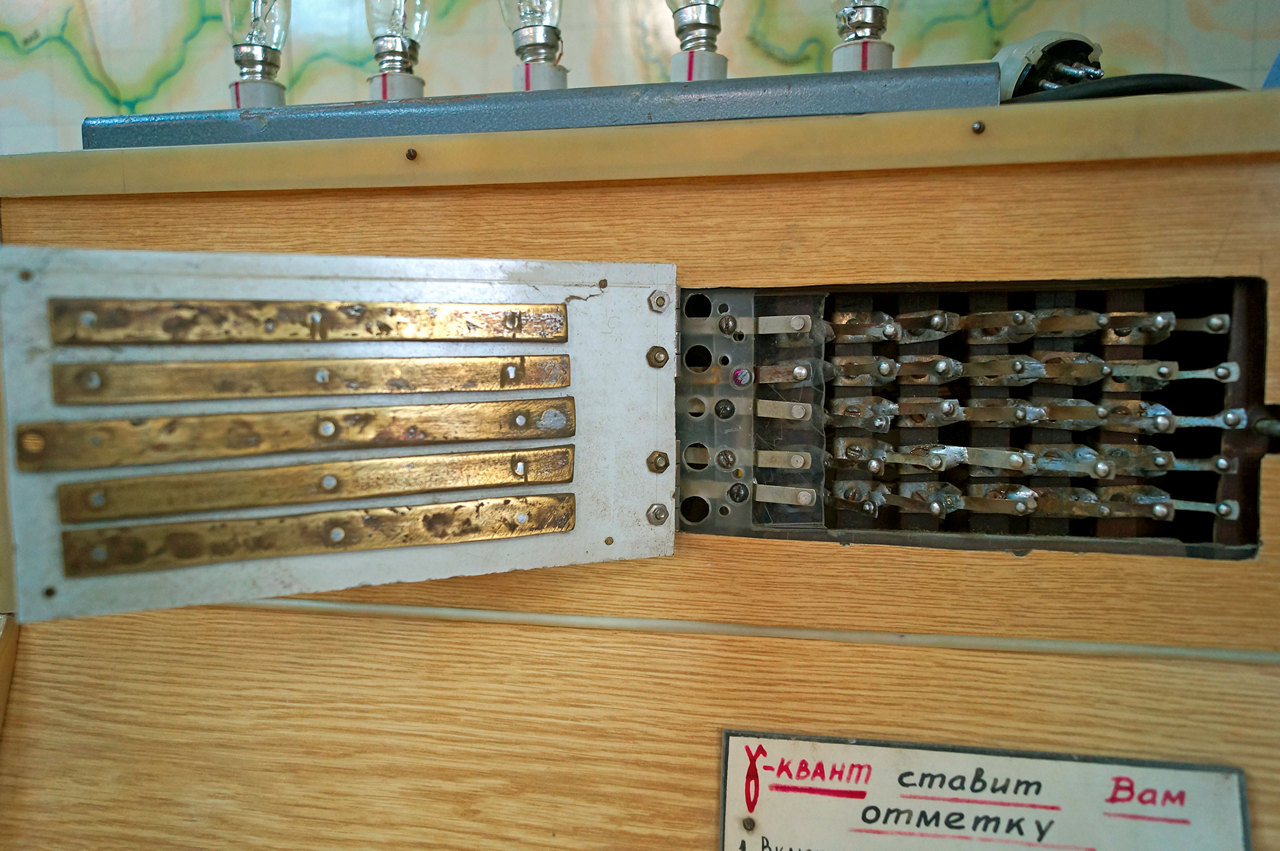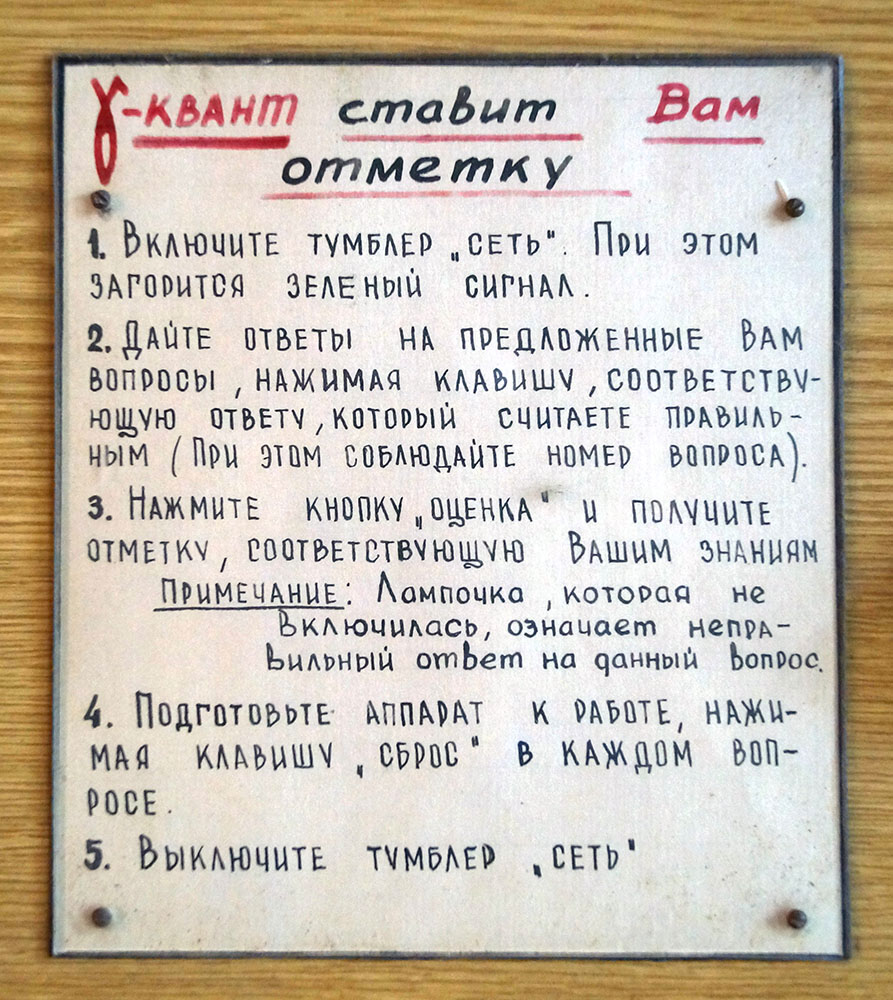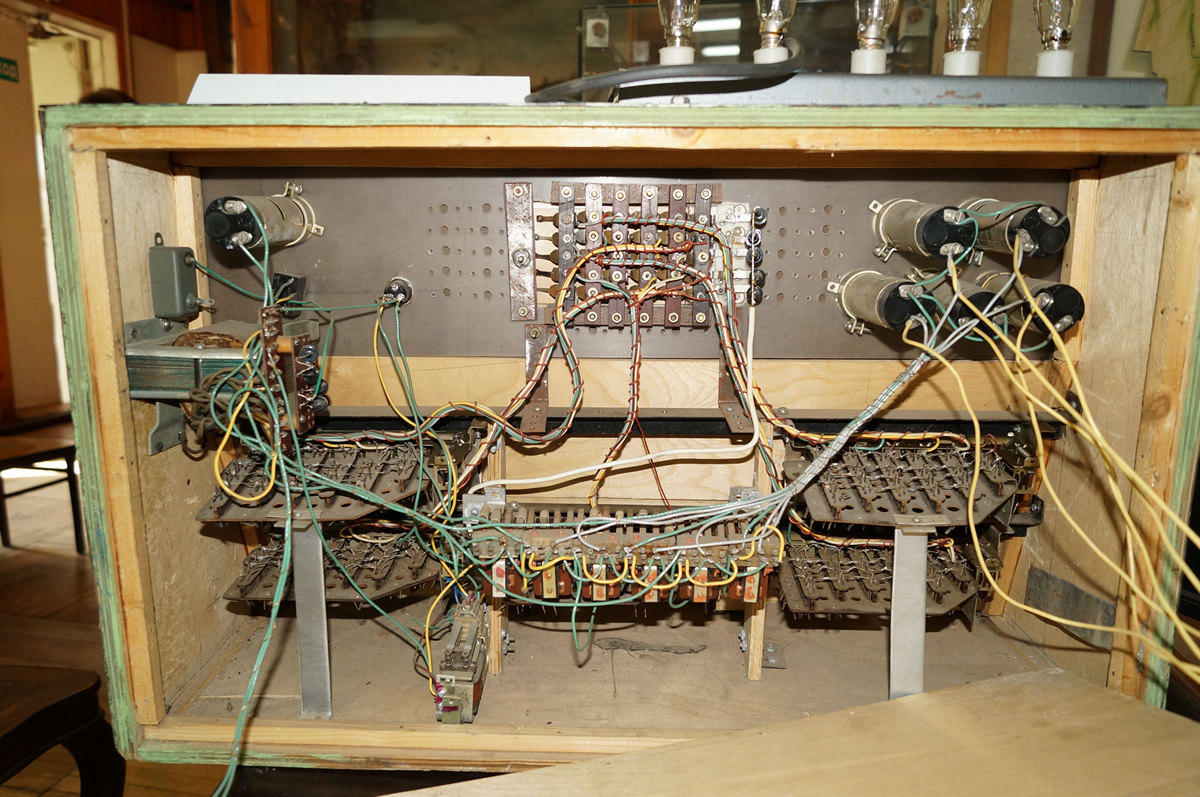The history of one device: the path to knowledge control through technical creativity
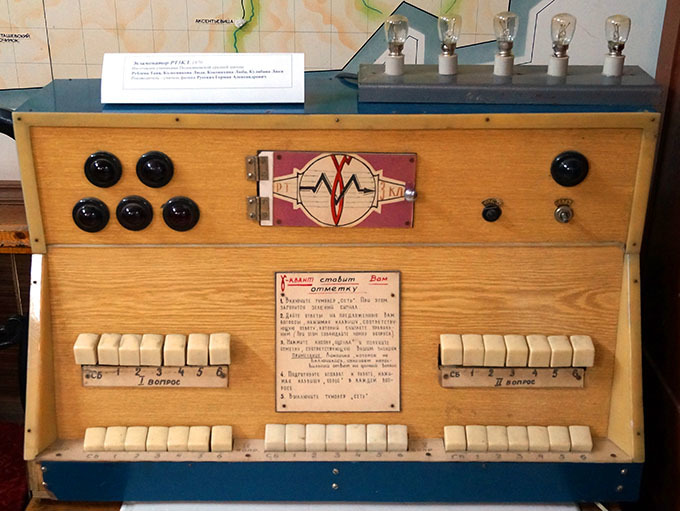
Preamble
In the summer of 2014 I was passing through the village of Podosinovets, Kirov Region. I went to the local museum , the exposition turned out to be rich and interesting, began to get acquainted with curiosity and suddenly, among the household utensils and rural life, I saw a device that looked like a Soviet radio line. However, it turned out not to be a radiologist, but a certain “Examination RT3KL”. The accompanying plate explained that it was made in 1970 by five students (or, more precisely, schoolgirls!) Of the Kirovo-Chepetsk school under the guidance of the teacher of physics German Aleksandrovich Russkikh. It intrigued, I asked the museum staff for details about the history and design of the device. They explained that the device was handed over to the museum at the end of the 2000s by Herman Alexandrovich, they offered to learn all the details from him. But I could not contact right away, so I began to look for information on my own.
Who is interested in the device as well as me, please under the cat. Careful traffic: a lot of photos, most of them clickable.
It turned out that the “Examiner” was visually similar to the “Siberian” examiner that was very popular in those years, and I decided that this was one of its modifications.
Big spoiler about Sibiryak, other electromechanical examiners and theory of testing
In the 1960s, more than 2,000 designs of similar devices were developed in the USSR; at that time they were called technical means of programmed instruction. Of these, about 20 were recommended by the commission for the scientific examination of technical means of programmed instruction of the Ministry of Higher and Secondary Special Education of the USSR for broad experimental use in educational institutions.
')
The most functional was the examiner "Sibiryak", the scheme of which was published in 1968 in No. 6 of the magazine "Radio". The author of the examiner and the article is Marhel Ivan Ivanovich, a candidate of pedagogical sciences, a teacher at the technical school named after Zhukovsky (Omsk). "Sibiryak", made in the technical circle of the technical school under the leadership of I.I. Marhel, in 1966 received a bronze medal at the Exhibition of Economic Achievements, and then with the exhibition "Soviet Youth" was exported to Poland, Romania, Hungary, Czechoslovakia, the GDR and even the United States. The design of Sibiryak included 120 code programs, which made it possible to monitor students' knowledge of 120 topics with 25 tickets (5 questions per ticket) for each topic, and to work with the machine on several courses in parallel. The “Sibiryak” scheme proved to be very successful and the examiner was made industrial and artisanal across the country in various modifications. There is even information that such examiners are still used in some technical schools.

Marhel Ivan Ivanovich

"Sibiryak" from a journal article
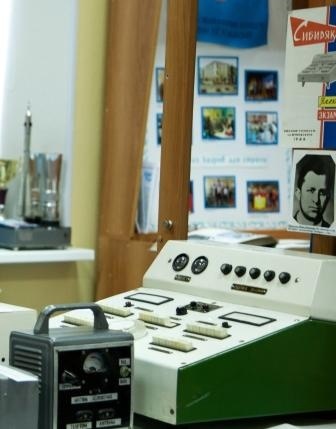
Industrial version of "Siberian"
A variety of examiners' schemes were regularly published in the magazine “Radio” and the collections “To the Amateur Radio Aid”, but the main publications were already in the 70s. The examiners were recommended for wide use in the educational process, and many, judging by the publication in the sections of the magazine “To Help Primary and Educational Organizations DOSAAF”, were focused on passing traffic rules.
By the way, it didn’t do without technical “glitches” familiar to us and funny flaws. Here, for example, the observation from the comments on the article Avdyunichev Yu. Photo examiner (“Radio.” 1974. No. 12): “the examiner can be“ deceived ”and get a grade of“ 5 ”. To do this, answering the question, it is imperceptible for the teacher to alternately press the buttons of all the answers. ”
It is interesting to see how attitudes towards examiners changed. Initially, full acceptance, then skepticism and much more careful application.
In the comments to the article by V. Eremeyev. The examiner at MTH-90 (Radio. 1975. No. 11), the editors noted:
"The examiner at MTH-90", like most of these structures, the descriptions of which were published in the pages of the magazine "Radio", is built on the principle of selectively entering the response code. A significant disadvantage of this method is the need to compile programmed tickets and the possibility of accidentally “guessing” the correct answer. Therefore, in the future, the editors will publish descriptions of examiners of this type only if they have original technical solutions.
Radio amateur designers, specializing in the creation of technical means of education, the editorial board recommends developing the most promising examiners - with an “effective response”. The control questions in them do not contain a series of answers with one correct answer, and the examiner enters the answer into the machine by dialing the corresponding numeric or alphabetic code.
Currently, test control is used extremely widely in all areas of education. Critics of the method, of course, a lot, but the USE did not kick only lazy. But the theory of testing is well developed (see, for example, the works of Avanesov and Mayorov) and, with a competent approach, can significantly ease the work of teachers and reduce the subjectivity of knowledge control.
1. Marhel I. “Sibiryak” EE-II-M4 // Radio.1968. №6. P. 14-17.
2. We answer letters. Once again about the car "Sibiryak" // Radio. 1971. №9. P. 57.
3. Avdyunichev Yu. Photo examiner // Radio. 1974. №12. Pp. 28-29.
4. Osaulko A. On the basis of Sibiryak // Radio.1975. Number 3. Pp. 26-27.
5. Fedorov Y. Electronic examiner // Radio. 1975. №7. Pp. 16-19.
6. V. Eremeev. Examiner for MTH-90 // Radio.1975. №11. C 17.
7. Mayorov A.N. The theory and practice of creating tests for the education system. (How to choose, create and use tests for educational purposes). M .: Intellect Center, 2001. 296 p.
8. Avanesov V.S. The composition of the test tasks. M .: Testing Center, 2002. 240 p.
')
The most functional was the examiner "Sibiryak", the scheme of which was published in 1968 in No. 6 of the magazine "Radio". The author of the examiner and the article is Marhel Ivan Ivanovich, a candidate of pedagogical sciences, a teacher at the technical school named after Zhukovsky (Omsk). "Sibiryak", made in the technical circle of the technical school under the leadership of I.I. Marhel, in 1966 received a bronze medal at the Exhibition of Economic Achievements, and then with the exhibition "Soviet Youth" was exported to Poland, Romania, Hungary, Czechoslovakia, the GDR and even the United States. The design of Sibiryak included 120 code programs, which made it possible to monitor students' knowledge of 120 topics with 25 tickets (5 questions per ticket) for each topic, and to work with the machine on several courses in parallel. The “Sibiryak” scheme proved to be very successful and the examiner was made industrial and artisanal across the country in various modifications. There is even information that such examiners are still used in some technical schools.

Marhel Ivan Ivanovich

"Sibiryak" from a journal article

Industrial version of "Siberian"
A variety of examiners' schemes were regularly published in the magazine “Radio” and the collections “To the Amateur Radio Aid”, but the main publications were already in the 70s. The examiners were recommended for wide use in the educational process, and many, judging by the publication in the sections of the magazine “To Help Primary and Educational Organizations DOSAAF”, were focused on passing traffic rules.
By the way, it didn’t do without technical “glitches” familiar to us and funny flaws. Here, for example, the observation from the comments on the article Avdyunichev Yu. Photo examiner (“Radio.” 1974. No. 12): “the examiner can be“ deceived ”and get a grade of“ 5 ”. To do this, answering the question, it is imperceptible for the teacher to alternately press the buttons of all the answers. ”
It is interesting to see how attitudes towards examiners changed. Initially, full acceptance, then skepticism and much more careful application.
In the comments to the article by V. Eremeyev. The examiner at MTH-90 (Radio. 1975. No. 11), the editors noted:
"The examiner at MTH-90", like most of these structures, the descriptions of which were published in the pages of the magazine "Radio", is built on the principle of selectively entering the response code. A significant disadvantage of this method is the need to compile programmed tickets and the possibility of accidentally “guessing” the correct answer. Therefore, in the future, the editors will publish descriptions of examiners of this type only if they have original technical solutions.
Radio amateur designers, specializing in the creation of technical means of education, the editorial board recommends developing the most promising examiners - with an “effective response”. The control questions in them do not contain a series of answers with one correct answer, and the examiner enters the answer into the machine by dialing the corresponding numeric or alphabetic code.
Currently, test control is used extremely widely in all areas of education. Critics of the method, of course, a lot, but the USE did not kick only lazy. But the theory of testing is well developed (see, for example, the works of Avanesov and Mayorov) and, with a competent approach, can significantly ease the work of teachers and reduce the subjectivity of knowledge control.
Literature
1. Marhel I. “Sibiryak” EE-II-M4 // Radio.1968. №6. P. 14-17.
2. We answer letters. Once again about the car "Sibiryak" // Radio. 1971. №9. P. 57.
3. Avdyunichev Yu. Photo examiner // Radio. 1974. №12. Pp. 28-29.
4. Osaulko A. On the basis of Sibiryak // Radio.1975. Number 3. Pp. 26-27.
5. Fedorov Y. Electronic examiner // Radio. 1975. №7. Pp. 16-19.
6. V. Eremeev. Examiner for MTH-90 // Radio.1975. №11. C 17.
7. Mayorov A.N. The theory and practice of creating tests for the education system. (How to choose, create and use tests for educational purposes). M .: Intellect Center, 2001. 296 p.
8. Avanesov V.S. The composition of the test tasks. M .: Testing Center, 2002. 240 p.
However, later, when correspondence with German Alexandrovich began, he explained that he had not heard about Sibiryak, and that the Examiner had completely original design, which had further stimulated my interest. He also said that with schoolchildren they made a lot of rather complicated devices, and the “Examiner” had a predecessor with the name “Flashlight”. And in 1971, in honor of the 10th anniversary of the first manned flight into space, a school launching center (!) Was organized with the launch of various missiles and various services (the launch team, the spent missile search service (the last stage descended by parachute) and returning them to launch, speakerphone service (reported the name of the designer, type of rocket, etc.), service of the launch of the launch track, etc.).
In addition, German Alexandrovich was an active shortwave, in the late 50s at the All-Union competitions in VHF communications received the second sports category.

G.A. Russian in the fourth year of the institute with a radio-gram-recorder (in the present, the music center) of its design
Now German Aleksandrovich is 82 years old, but he does not leave technical creativity and publishes his developments in the magazine “Household Farm”. From recent articles: “Sliding gates” for a kitchen garden (No. 7, 2016) and “Handmade well” on the independent production of a well for water inside the house (No. 1, 2017).
In August of this year, we managed to visit Podosinovets again and finally communicate with Herman Alexandrovich in person, listen to his story about the creation of the “Examiner” and watch the device in action.
I suggest using the example of the “Examiner” story to get acquainted with the school technical creativity of the Soviet years. Of course, as now, it was largely held by enthusiasts, but it was widespread throughout the country, not only in large cities, and was supported by the state. During school years, I myself was engaged in completely free radio circles at the school and the Station of Young Technicians. It is interesting and useful to compare with the current situation.
German Alexandrovich kindly agreed to prepare an article on the history of the device, giving him the floor.
***
G.A. Russian. "He is still examining"
It was in the late sixties of the twentieth century. In the accounts, they counted on Russian accounts, the mechanical Felix arithmometer was available only to large enterprises and organizations, and computers were in individual scientific centers and in terms of volume they occupied entire halls. If at that time someone said that the calculator could be a matchbox size, and three wireless telephones could fit in the palm of your hand, then such a person would be called a mad dreamer. But technological progress was developing rapidly and the science of cybernetics, developed by N. Wiener in the late forties, already firmly occupied a place in the scientific world.
At that time, I worked as a physics teacher at school No. 8 in Kirovo-Chepetsk and led a circle of children's technical creativity in which students of 6-10th grades were engaged. There, in their interest and capabilities, they built existing devices and models. Here are some of the most interesting in design and execution: a device for demonstrating the daily rotation of the Earth, an automatic camera switch on when the light is turned off in a darkened audience, a rocket launcher operating synchronously with a radar station, a squadron with programmed control, and others.
Once in class, talking about cybernetic devices, he said that each of those present had a part of a cybernetic device. The guys rummaged through their bags and pockets to find it. They were genuinely surprised that part of the cybernetic device was the key to the lock of the apartment. I had to explain that the key “recorded” on the key, with which the lock on the door’s locking mechanism is released.
The device "Flashlight"
When conducting physics lessons, I was faced with the problem of lack of time for oral student surveys, and, as a result, with a low accumulation of assessments. I had four classes of sixth-graders (and at that time in the sixth grade I started studying the physics course), and in order to instill a love for studying this difficult but interesting subject, I had to tell a lot and demonstrate suitable experiments. It took a lot of time.
It was obvious that it was necessary to apply some new methods of effective control of students' knowledge, which require less time, but fit into the time period. And it was desirable that the children themselves participated in the assessment of their knowledge. Discussing with the guys and analyzing various ideas, they came to the “invention” of a simple “Flashlight” device, as the students called it. Moreover, the main part of the system was made by pupils at home according to explanations received in the classroom. In the manufacturing process, they mastered the use of a millimeter ruler, accurate readings on it, work with a well-sharpened pencil, neat work with paper, etc., that is, everything that they will have to face in carrying out laboratory work, studying physics. For the manufacture of the "line" (bookmarks) received an assessment for the practical work that is exhibited in the journal. The name “ruler” arose because the students used it to draw straight lines, underscores, and at the same time it was a bookmark in a textbook or in a notebook.
The “ruler” consisted of three parts: “pocket”, “envelope”, and “liner” (see detailed photo below) .
The “pocket” was made of cutting 35 mm film, washed from the emulsion, bent so that the windows of the perforation coincided, and the total length was 185 mm. The sides were perforated through thick threads on both sides. It turned out a flat transparent pocket with a width of 25 mm and a length of 180 mm with smooth edges, which could be used as a ruler.
An “envelope” made of thick paper was inserted into the pocket. Over the entire length, it had a cutout of 8x145 mm from the middle line. The side and end edges of the envelope are closed so that they do not overlap the window - cut. When closed, it should freely, but tightly enter into the "pocket".
In the "envelope" inserted "liner", also made of thick paper. Subsequently, he began to be called "answer", because on it the pupil's answer to the ticket was encrypted. This is a strip of paper 20 mm wide and 160 mm long, divided vertically into two fields of equal width. Having retreated from the upper end of the strip of 20 mm, five zones (by the number of questions in the ticket) 25 mm each are drawn. Each zone of the right side is cut into five equal parts - tongues, - these are the answers. When answering, one tongue of each zone is bent and pressed against the uncut part of the left margin. By folding one tongue in each zone, five transparent windows are obtained. This will be an encrypted answer to five questions. In this form, the “liner” is neatly placed in the “envelope”, and the “envelope” - in the “pocket” - you can go for an assessment to the “Flashlight”.
Even the formula of such an answer was invented: “Take a ticket — the answer in the envelope — the envelope in the pocket — it in the Flashlight!”
The flashlight is a vertical triangular prism made of opaque daylight material. In our case - thin red plexiglass. Each facet of the prism outside has grooves into which a “charged” ticker and a punched card are inserted. The punch card has windows that match the correct answer. With the correct answer of the respondent, the map windows will match the windows of the ticker. There are two 10 W electric lamps in the flashlight, a permanently open button is mounted on top of the flashlight. The respondent presses the button - the flashlight is illuminated from the inside, and on the verge of the flashing windows is the evaluation of the answer. It turns out that the student himself puts an assessment. Quickly and objectively.
The punched card is made of thick black paper, has five windows two times wider than the answer windows. This avoids trouble if the student inserts a ticker with the wrong side. Since the flashlight has three faces, three students can simultaneously respond. And if you insert the card "upside down", you get three more options for the correct answer. You can check the ticker without a flashlight - just attach the punch card to the ticker, but as a rule, children disagree. The emotional component here is very bright.
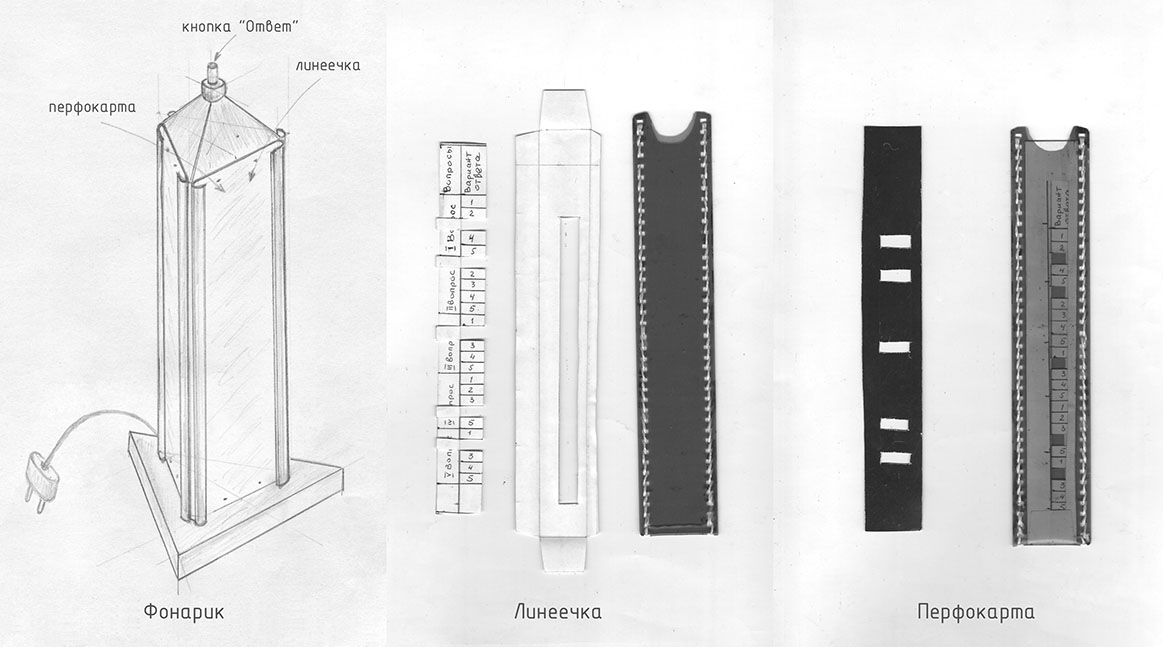
Flashlight device, tickers and punch cards
Work on making the ticker, refueling the ticker when responding to a ticket, installing a ticker in a flashlight and ... pressing a button! - this is all connected with the focus of attention. At first glance, it seems that such subtle actions are beyond the reach of children. But practice shows that children do better than adults where they need fine motor skills.
Using the “Flashlight”, it became easy to test the knowledge of 15 students without sacrificing time to explain the new material, yes, and it was also possible to carry out verification work without spending a whole lesson. Just had to collect the tickers and check them yourself.
What is interesting for a sixth-grader is primitive for a high school student. It was necessary to invent something new. And the “Examiner” RT-3-KL was invented.
Device "Examiner"
I offered to make an electrical apparatus with my own hands in the classroom, which allows to check knowledge and give marks for answers. To make such a device, four female students of the 10th grade expressed their desire.

"Club of Young Masters" is going to the next lesson
Neither the drawings nor the electrical circuit was not, so they began to work from scratch. Based on what parts for the manufacture of "EXAMINER" (as the girl's apparatus was called) could be purchased at that time.
The main principle of operation of the conceived apparatus - like modern computers, mobile phones, ATMs and other electrical machines - is to fix the passage of electric current or its absence in electrical circuits according to a certain program. At present, even a preschooler knows what a SIM card and PIN code are, which is the basis of devices of this class, and at that time these concepts were unknown to ordinary people. When we click on the buttons of a mobile phone or ATM, we close / open the electrical circuits and the device provides us with the subscriber or issues a banknote if our actions coincide with the PIN code of the device.
For the controls, we purchased the key switches of the radio receiver ranges, the electromagnetic relays became the actuators. For fixing the results - light bulbs. The SIM card was a “contact” card with a punched card, made independently, and the PIN-code - a combination of holes on the punched card. The body of the examiner was made of plywood and plastic.
During the year the girls sawed, drilled, soldered. Not everything worked right away. The examiner was born by the method of "trial and error", reworked, until they achieved the desired result. If you look at the photo where the girls are making the contact panel, then you will notice that it has been heavily re-profiled. At first, they planned to encode the correct answer with plugs with split sockets, but then abandoned this option.
They came up with the name of the examiner - “Y-QUANT” (from the Y-radiation of the atom of radioactive substance and photon energy), the initials of the names and names of the girls-masters were entered into the digital index “RT-3-KL” - Rubleva Tanya, Kolesnikova Lyuda, Kokovikhina Lyuba, Lyuba Kuljatina. The full name is “Y-QUANTUM RT-3-KL”.

Rubleva Tanya and Lyuba Kuljatina assemble keyboard switches
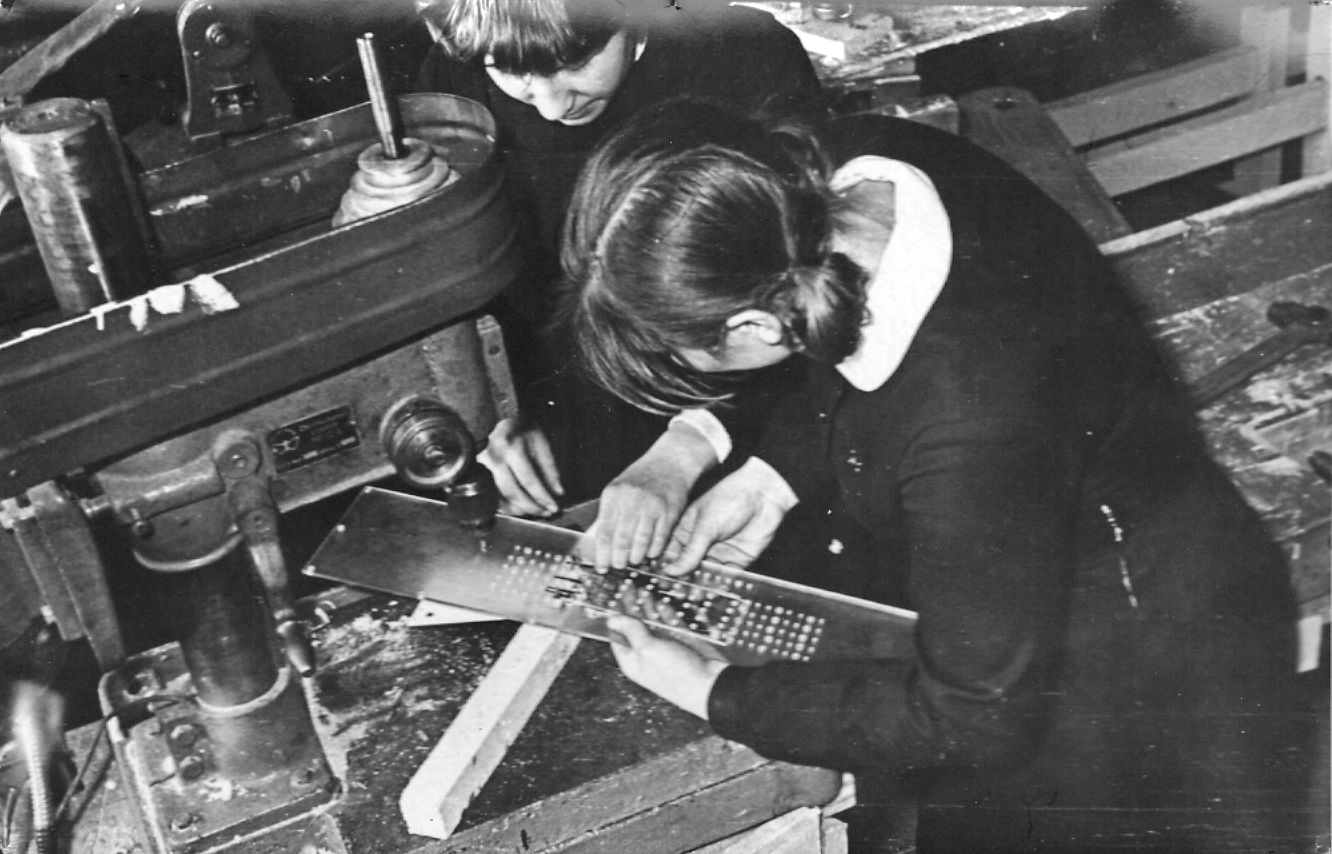
Kokovikhina Lyuba and Kolesnikova Lyuda fabricate the base of the contact panel
How does the machine work?
Examined receives a ticket with five questions (as when passing the exam). Each question has its own block of key switches: 5 questions - 5 switches. The ticket for each question contains 6 answer choices, one of which is correct. On the switch block, there are 7 keys: the first “RESET” - to bring the switch to zero position after the answer, the remaining 6 are the answers to the corresponding question. A pin card with a PIN-code is put on the contact card. The student who received the ticket turns on the machine, presses the key corresponding to the chosen answer option on each switch block, then presses the ESTIMATE key. If the combination of keystrokes coincides 100% with a PIN code, 5 lights come on - “GREAT” rating, 80% - “GOOD”, 20% - one light comes on - “VERY BAD” or “QTY!” students say. Less than 20% match - not a single bulb lights up. This means that knowledge of the proposed questions is not available to the examinee.
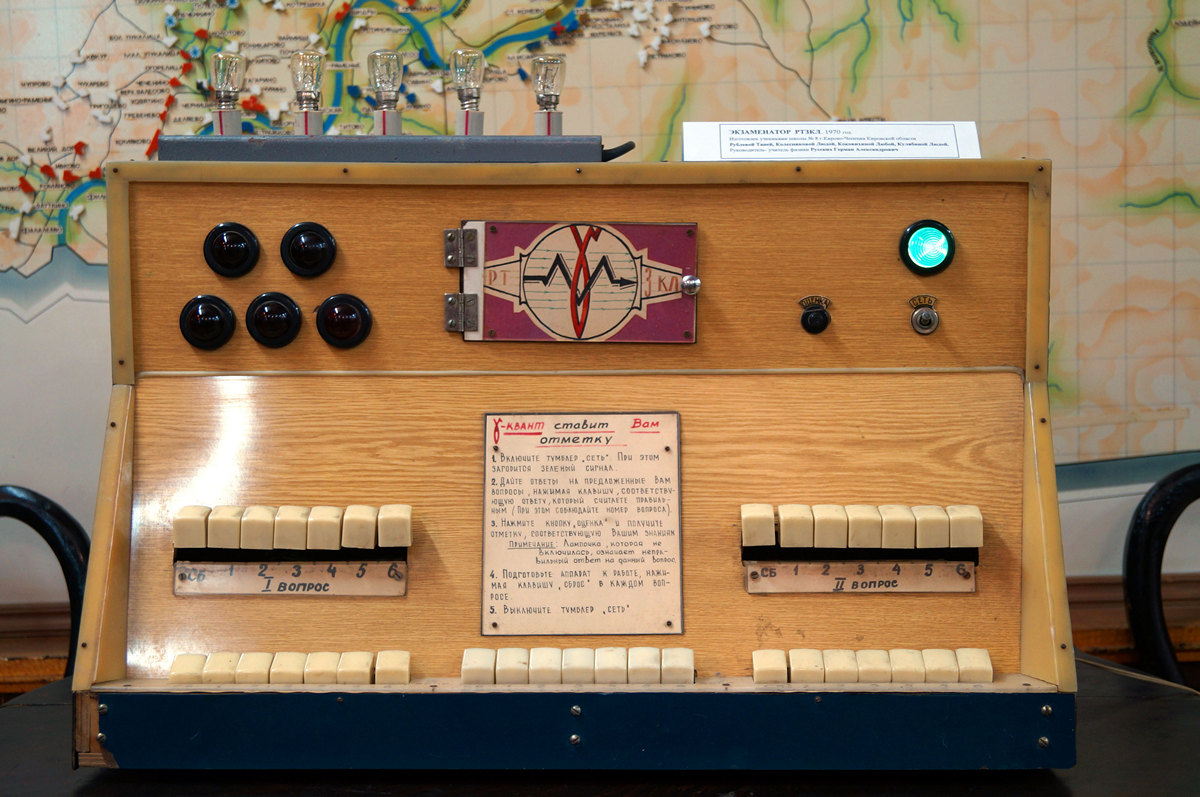
Detailed view of the examiner. Green Ready light is on

German Alexandrovich explains the device of the examiner. The warning lights show a rating of "5". In the background is a beautifully executed map of Podosinovsky district
Additional photos of the device device
The examiner was used in the lessons and allowed for the time allotted for the survey to check the knowledge of 10-15 students. It was exhibited at the city, district and regional exhibitions of children's technical creativity, where there were always many who wanted to test their knowledge on the proposed issues. Later it was used for testing during certification of the chief engineers of the Kirovo-Chepetsk construction department. In recent years, the examiner has been on display at the Podosinovskiy Local Lore Museum, where you can check its performance and “integrity”. He regularly serves over 40 years.
When using the examiner revealed his shortcomings, which should work:
1. The result of the answer to the class is not visible, since the device was placed with the back wall to the seated students.
2. Large dimensions and a decent weight did not allow using it mobile, i.e. the device should be in the same room.
3. It took quite a lot of time to replace punched cards - this is not a rational use of the time-study.
4. The keys of the switches, when pressed, required a lot of effort, and they remained pressed until the respondent was finished working with him.
We eliminated the first drawback quickly - in parallel with the signal lamps of correct answers, we installed 5 lamps in a separate block and connected it with a cable through an 8-pin panel. The well could be set on the table or on the body of the device.
Began to complete parts for the next model of the examiner. Tight and dimensional keyboard switches decided to replace the bell buttons. Instead of the contact panel with a punched card, put the phone dial of the dialer. And to replace the marker signal lamps with a digital indicator lamp.
But this project was not destined to be realized - I moved from the teaching to a large construction organization, where I worked for more than twenty years. And the device RT-3-KL continued to serve me.
By chance, more than 40 years later, I learned that a similar device had been manufactured and even mass-produced in Siberia, and was called “Siberian”. It is a pity that I at that time had already moved away from amateur radio and did not read the magazine Radio. The way of making our examiner would be shorter, and he would have been made more professionally. I suppose similar constructions were made in other schools. At that time, technical creativity circles were actively working in many schools, city, regional and regional exhibitions of children's technical skills were held. A major role in the popularization of technical creativity was played by the regional Station of Young Technicians, the Model Designer magazine and other publications for children and youth.
Conclusion
In conclusion, a few thoughts about the current situation with the school technical creativity.
In terms of age and social status, I currently have little contact with schoolchildren and young people, and I don’t know the details of school plans and programs. But, following media reports, I must conclude about the passivity of schoolchildren in children's technical creativity. I haven't heard about technical circles in schools, about exhibitions of children's constructions at different levels, about the competitions of young designers of aircraft and ship models, various models of machines and mechanisms.
What is the reason for such passivity?
I think there are several reasons.
The first, oddly enough, the change in the spiritual and moral state of society: a great need for entertainment and pleasure, rather than in creation and creative thinking.
The second is the tremendous technical progress in the means of communication, which has led to the most "terrible" laziness - the laziness of the mind, the desire to think independently, to do with your own hands what you like and know how to use various tools.The computer from the tool for creative activity has become a means of obtaining pleasure without any mental work with his own head. It is easier for a person, especially at a young age, to be counted on a calculator or to find an answer on the Internet (sometimes of doubtful authenticity) than to solve the problem on your own and answer the question based on the knowledge gained in school. And computer games have become the main obstacle to the creative design ideas of the student. Boys do not know how to "nail the nail", but succeed in computer games. And what is more useful in life? - This is a moot point.
The third is the family, which in many cases has become a hotbed of entertainment and pleasure, instead of mental and technical creative work in the family circle.
Fourth, there have been few initiative teachers, leaders of children's groups who are able to captivate children with interesting work that could become their profession in the future. Here we need people who are in love with working with children and who themselves are role models.
Of course, children's technical creativity will not die at all, because the curiosity of the child will still manifest (at least in some part of the children), and he wants to do something with his own hands. It's nice that in some places pockets of robotics have appeared. Exhibitions and competitions are held. But only robots are not enough.
The creativity of children needs to be expanded, introduced into the daily life of the school. For this, it is necessary to organize the production of microelectronic parts, micromechanics, component parts for children's design. Make available at a price and supply them with schools as consumables. In every possible way to “seek out” the initiative leaders of children's technical creativity, including in the workplace. To encourage them in all possible ways, including financially, to take care of them and keep them at their best, just like the leaders of adult production, remembering that they are raising future engineers and designers, the future of the Kulibins and Korolevs. This is the task of all levels of government. Russia can not be on the outskirts of world technical progress.
Source: https://habr.com/ru/post/403559/
All Articles

